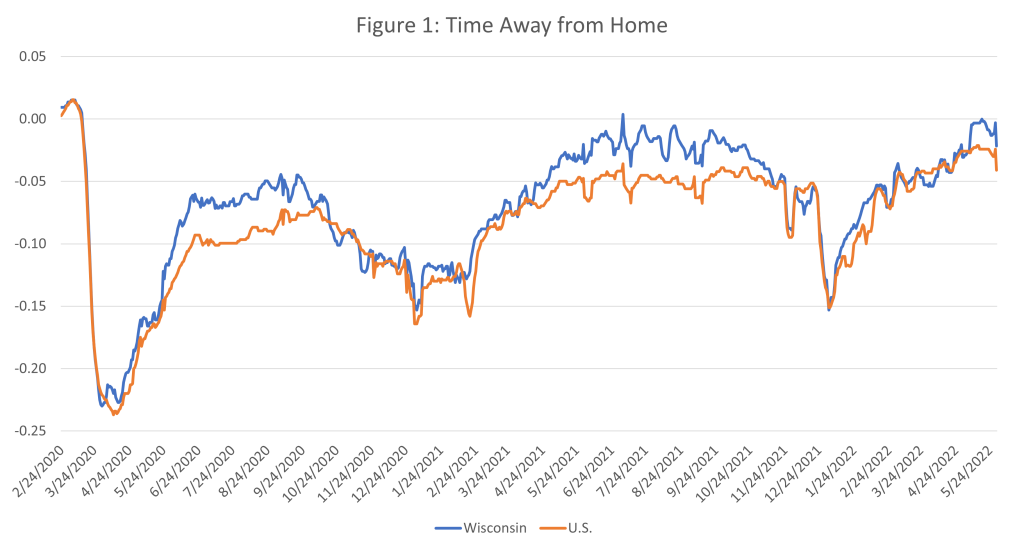(Image Source: Aron Visuals / Unsplash)
Wisconsin IDEA
Insight • Data • Economics • Analysis
Mobility Data on “Time Away from Home” Nearing Pre-Pandemic Levels, Not the Case for “Time Away from Work”
The COVID pandemic has impacted the economy and our lives in very different ways. In the early days of the pandemic people were encouraged to shelter in their homes to minimize the spread of the disease. But as the risk of infections, and more relevant death, has declined people are attempting to return to pre-pandemic behavior. One way to track the behavior of people over the period of the pandemic is to track their mobility using GPS from smartphones. Google, in the response for the need for information to help form policies in response to the pandemic, created the Google COVID-19 Community Mobility Reports and has made much of the data available to researchers.

Using these data, one can see the impact of the initial “stay-at-home” orders (Figure 1). Wisconsin tracks the national pattern from the start of the pandemic up to the most current data (5/30/2022): the initial reaction which peaked in the middle of April (4/14/2020) with a slow return but incomplete return in the summer of 2020, the impact of the second wave of COVID in the fall-winter, the slow recovery though much of 2021 and then the third wave of COVID in January-February of 2022. The pattern of waves of COVID and recovery is clear in the mobility data.
While the general “time away from home” mobility data points to periods where we came close to returning to pre-COVID levels, there is one insight from these data that point to what is perhaps a structural change in the economy resulting from the pandemic. Specifically, the “time away from work” patterns (Figure 2). Many pundits were claiming that the pandemic would fundamentally alter the economy and the evidence suggests that if such a structural change occurred it is in the nature of work. Under the initial “stay-at-home” orders and people’s hesitation to expose themselves to COVID many worker began to work from home. This has been called both telecommuting and remote working, but the notion is that for many jobs being physically present in the workplace (e.g., office) is not necessary. Wisconsin tend to again follow the national pattern, but the general levels of returning to the work place is consistently, albeit modestly, higher for Wisconsin. This is likely due to the nature of many jobs in Wisconsin where remote working is not possible.

In the initial periods of the pandemic and a large number of people began to work from home, many businesses experienced positive outcomes. In many cases worker productivity modestly increased and the expenses associated with office space could be reduced. In addition, in the current period of labor shortages, many businesses found that their pool of potential job candidates was not limited to a narrow geographic territory. For example, if a business was hiring an accountant and the person could work remotely, it becomes irrelevant where that account is physically located. This is preconditioned on the availability of quality broadband services.















